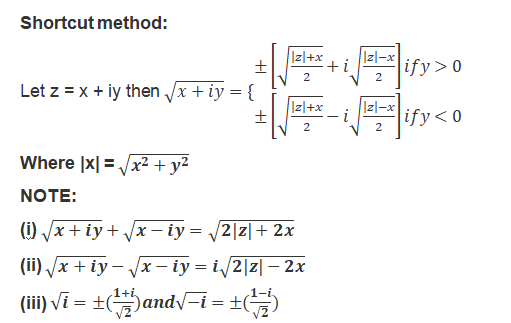- Books Name
- AMARENDRA PATTANAYAK Mathmatics Book
- Publication
- KRISHNA PUBLICATIONS
- Course
- CBSE Class 11
- Subject
- Mathmatics
Square Root and Cube Root Of Complex Numbers:
Square roots of a complex number
Let the square root of a + ib be x + iy
That is = √[a+ib] = x + iy where x, y ∈ R
a + ib = ( x + iy )2 = x2 - y2 + i2xy
Equating real and imaginary parts, we get
x2 - y2 = a and 2xy = b
(x2 + y2 )2 = (x2 - y2 ) 2 + 4x2 y2 = a2 + b2
x2 + y2 = √[a2+b2], since x2 + y2 is positive
Solving x2 + y2 = a and x2+ y2 =√[a2+b2], we get

Since 2xy = b it is clear that both x and y will have the same sign when b is positive, and x and y have different signs when b is negative.

Formula for finding square root of a complex number

Note

Example 1.
Find the square root of 6 - 8i.
Solution
We compute |6 - 8i| = √[62 + (-8)2] = 10
and applying the formula for square root, we get

Example 2: Determine the square root of complex number 3 + 4i.
Solution: To determine the square root of 3 + 4i, we will determine its magnitude and compare with a + ib.
|3 + 4i| = √(32 + 42) = √(9 + 16) = √25 = 5; a = 3 and b = 4 > 0
Therefore, using formula for square root of complex numbers, we have
√(3 + 4i) = ± (√[√(5 + 3)/2] + i√[√(5 - 3)/2] )
= ± (√(8/2) + i √(2/2))
= ±(√4 + i√1)
= ± (2 + i)
Answer: Hence, √(3 + 4i) = ± (2 + i)

Cube Root of Unity Values:
Suppose the cube root of 1 is “x”,
i .e ., 3√1 = x.
According to the general cube roots definition,
x3 = 1
-
- x3 – 1 = 0
since (a3 – b3) = (a – b) ( a2 + ab + b2)
Now, (x3 – 13) = 0
-
- (x – 1)( x2 + x + 1) = 0
Therefore,
x = 1 Or ( x2 + x + 1) = 0
-
- x=1 or x = [(-1) ± √(12-4.1.1)]/2
- x=1 or x= [-1 ± √-3]/2
- x=1 or x= -1/2 ± i√(3)/2
Therefore, the three cube roots of unity are:
1, ω= -1/2+i√(3)/2, ω2= -1/2 – i√(3)/2
Properties of Cube roots of unity
1) One imaginary cube roots of unity is the square of the other imaginary cube root.
= ¼ [(-1)2 – 2 × 1 × √3 i + ( √3 i)2] = ¼(1 – 2√ 3i – 3) = (-1-√ 3 i) /2
And
= ¼ [(-1)2 + 2 × 1 × √3 i + ( √3 i)2] = ¼(1 + 2√ 3i – 3) = (-1+ √ 3 i) /2
i.e., ω2= (ω2)2
2) If two imaginary cube roots are multiplied then the product we get is equal to 1.
Let’s take ω = (-1 + √3 i ) /2
ω2 = (-1 – √3 i ) /2
Now we will get the product of two imaginary cube roots as ω x ω2 = [(-1 + √3 i ) / 2]x [(-1 – √3 i ) /2]
Or ω3 = ¼[(-1)2 – (√3 i)2]
= ¼[( 1 – 3i2) = ¼ x 4 = 1.
3) As there are three cube roots of unity, their sum is zero, let’s see how
= 1 + [(-1 + √3 i ) /2] + [(-1 – √3 i ) /2]
Or
1 + ω + ω2 = 1 – ½ + (√3 i ) /2 – ½ – (√3 i ) /2
= 0
4) conjugate of One imaginary cube roots of unity is equal to the other imaginary cube root.
Euler’s form of a Complex Number
eiƟ = cos Ɵ + i sin Ɵ
This form makes the study of complex numbers and its properties simple. Any complex number can be expressed as
z = x + iy (Cartesian form)
= |z| [cos Ɵ + I sin Ɵ] (polar form)
= |z| eiƟ
De Moivre’s Theorem and its Applications
(a) De Moivre’s Theorem for integral index. If n is a integer, then (cos Ɵ + i sin Ɵ)n = cos (nƟ) + i sin (nƟ)
(b) De Moivre’s Theorem for rational index. If n is a rational number, then the value of or one of the values of
(cosƟ + isinƟ)n is cos (nƟ) + i sin (nƟ).
In fact, if n = p/q where p, q ϵ I, q > 0 and p,q have no factors in common, then (cos Ɵ + i sin Ɵ)n has q distinct values, one of which is cos (nƟ) + i sin (nƟ)
The nth Roots of Unity
By an nth root of unity we mean any complex number z which satisfies the equation zn = 1 (1)
Since an equation of degree n has n roots, there are n values of z which satisfy the equation (1). To obtain these n values of z, we write 1 = cos (2kπ) + I sin (2kπ)
Where k ϵ I and ![]()
[using the De Moivre’s Theorem]
Where k = 0, 1, 2, …., n -1.
Note
The values of (cos Ɵ + I sin Ɵ)p/q where p, q ϵ I, q ≠ 0, hcf (p,q) = 1 are given by
![]()
Where k = 0, 1, 2, ….., q -1.

 KRISHNA PUBLICATIONS
KRISHNA PUBLICATIONS
